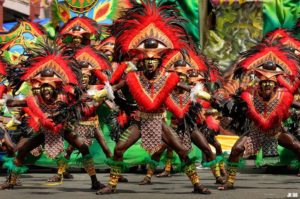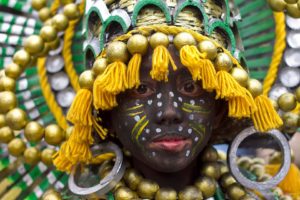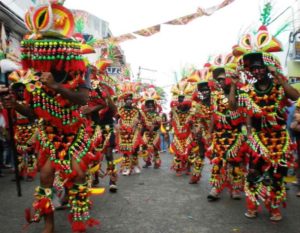Mother of All Philippine Festivals – the Ati-Atihan Festival
Posted By philippine evolution staff on June 28, 2017
philippine-evolution.com
ATI-ATIHAN FESTIVAL
The Ati-Atihan Festival is a feast held annually in January in honor of the Santo Niño (Infant Jesus), concluding on the third Sunday, in the island and town of Kalibo, Aklan in the Philippines. The name Ati-Atihan means “to be like Atis” or “make believe Ati’s”. Aetas, known colloquially as Ati, were the primary settlers of the islands according to history books. They too are the earliest settlers of Panay Island where the province of Aklan is located.[1]
The festival consists of tribal dance, music, accompanied by indigenous costumes and weapons, and parade along the street. Christians and non-Christians observe this day with religious processions. It has inspired many other Philippine Festivals including the Sinulog Festival of Cebu and Dinagyang of Iloilo City, both adaptations of the Kalibo’s Ati-Atihan Festival, and legally holds the title “The Mother of All Philippine Festivals” in spite of the other two festivals’ claims of the same title. Source
The name Ati-Atihan means “make-believe Atis. ” It has been known as the wildest among Philippine fiestas. The Ati-Atihan is a festival in honour of the Santo Niño. During the last three days of this week-long festival (fiesta), a parade is characteristic. A colourful happening with celebrants who paint their faces in many different ways and who are dressed in the most outstanding costumes.
The Ati-Atihan festival is named after the Ati, the indigenious natives of the island before the arrival of the Malay in the 10th century and the Spanish in the 16th century.
The festival is held on the third week of January every year on the second Sunday after Epiphany in Kalibo in the Aklan province on the island of Panay. The festival is to rejoice the arrival or gift of the Santo Niño by Magellan to the native Queen of Cebu in 1521 and is manifested by hyperactive merriment on the streets . The dancing on the rhythms of the drums makes this festival very similar to the Mardi Gras celebration in Rio in Brazil. Source
The people attend masses for the Santo Niño, and benefit dances sponsored by government organizations. The formal opening mass emphasizes the festival’s religious event. The procession begins with a rhythmic drumbeats, and dances parading along the street. The second day begins at dawn with a rosary procession, which ends with a community mass, and procession. The phrase “Hala Bira! Pwera Pasma!” is originally associated with the Sto. Nino Ati-Atihan Festival as the revelers and devotees keep on going with the festivities all over the town from morning to the wee hours of the next morning, rain or shine, for one week or even more. They believe that the miraculous Child Jesus will protect them from harm and illness. The highlight of the festival occurs on the last day, the third Sunday of January, when groups representing different tribes compete for tourists’ attention and prizes. The festival ends with a procession of thousands of people carrying torches and different kinds of images of the Santo Niño. The contest winners are announced at a masquerade ball which officially ends the festival. Source




[…] 1 – 2 – 3 – […]
[…] 1 – 2 – 3 – 4 […]
[…] 1 – 2 – 3 – […]